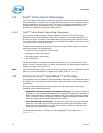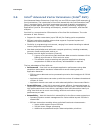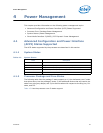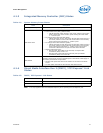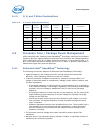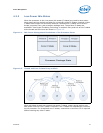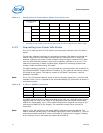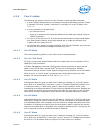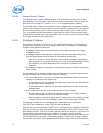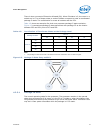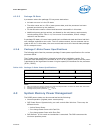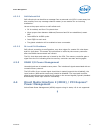
Power Management
34 Datasheet
Note:
1. If enabled, the core C-state will be C1E if all actives cores have also resolved a core C1 state or higher.
4.2.3 Requesting Low-Power Idle States
The core C-state will be C1E if all actives cores have also resolved a core C1 state or
higher.
The primary software interfaces for requesting low-power idle states are through the
MWAIT instruction with sub-state hints and the HLT instruction (for C1 and C1E).
However, software may make C-state requests using the legacy method of I/O reads
from the ACPI-defined processor clock control registers, referred to as P_LVLx. This
method of requesting C-states provides legacy support for operating systems that
initiate C-state transitions using I/O reads.
For legacy operating systems, P_LVLx I/O reads are converted within the processor to
the equivalent MWAIT C-state request. Therefore, P_LVLx reads do not directly result in
I/O reads to the system. The feature, known as I/O MWAIT redirection, must be
enabled in the BIOS.
Note: The P_LVLx I/O Monitor address needs to be set up before using the P_LVLx I/O read
interface. Each P-LVLx is mapped to the supported MWAIT(Cx) instruction as shown in
the following table.
The BIOS can write to the C-state range field of the PMG_IO_CAPTURE Model Specific
Register (MSR) to restrict the range of I/O addresses that are trapped and emulate
MWAIT like functionality. Any P_LVLx reads outside of this range do not cause an I/O
redirection to MWAIT(Cx) like request. The reads fall through like a normal I/O
instruction.
Note: When P_LVLx I/O instructions are used, MWAIT substates cannot be defined. The
MWAIT substate is always zero if I/O MWAIT redirection is used. By default, P_LVLx I/O
redirections enable the MWAIT 'break on EFLAGS.IF’ feature which triggers a wakeup
on an interrupt even if interrupts are masked by EFLAGS.IF.
Table 4-7. Coordination of Thread Power States at the Core Level
Processor Core
C-State
Thread 1
C0 C1 C3 C6 C7
Thread 0
C0
C0 C0 C0 C0 C0
C1
C0 C1
1
C1
1
C1
1
C1
1
C3
C0 C1
1
C3 C3 C3
C6
C0 C1
1
C3 C6 C6
C7
C0 C1
1
C3 C6 C7
Table 4-8. P_LVLx to MWAIT Conversion
P_LVLx MWAIT(Cx) Notes
P_LVL2 MWAIT(C3)
P_LVL3 MWAIT(C6) C6. No sub-states allowed.
P_LVL4 MWAIT(C7) C7. No sub-states allowed.



